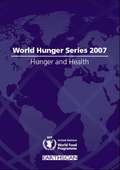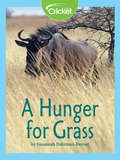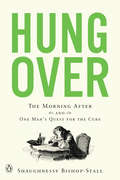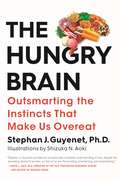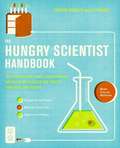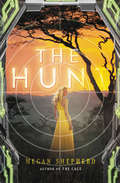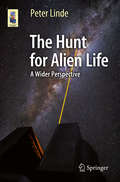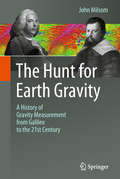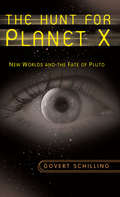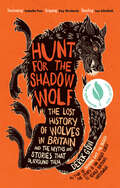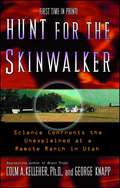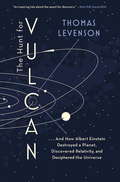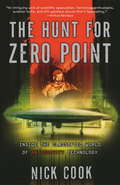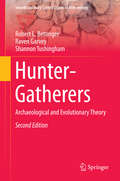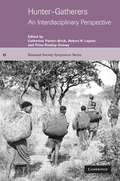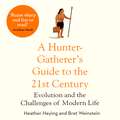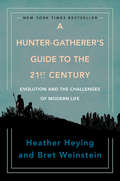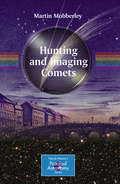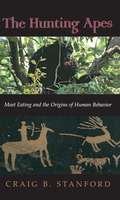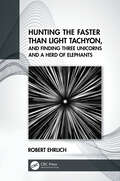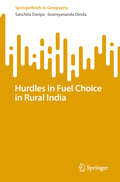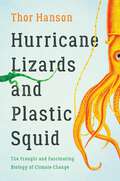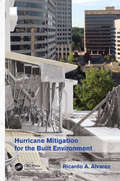- Table View
- List View
Hunger and Health: World Hunger Series 2007
by United Nations World Food ProgrammeHunger and Health explores the multiple relationships between hunger and poor health, and how they affect the growth of individuals, physiologically and psychologically, constraining the development of nations both socially and economically. Examining the profound effect that hunger has on health, including disease prevention and treatment, it gives special attention to access to quality food and healthcare, in particular for the marginalized and poor. It also identifies critical junctures in the human life cycle when the benefits of reducing hunger and improving poor health have a profound impact. It demonstrates how aligning of hunger and health interventions can offer proven solutions that reach those most in need, and contains compelling evidence which confirms that hunger and poor health are solvable problems today. It encourages those involved in policy, programming and advocacy to take action to address some of the most urgent hunger and health problems. Essential reading for anyone concerned about eliminating hunger. Published with the UN World Food Programme.
A Hunger for Grass
by Susannah Buhrman-DeeverThe wildebeests of the Serengeti follow the grass as it grows throughout the year.
Hungover: The Morning After and One Man's Quest for the Cure
by Shaughnessy Bishop-Stall"An engrossing, hilarious, and sometimes painful tour through the history and science of the morning after." —Bianca Bosker, author of Cork Dork One intrepid reporter's quest to learn everything there is to know about hangovers, trying all of the cures he can find and explaining how (and if) they work, all so rest of us don't have to.We've all been there. One minute you're fast asleep, and in the next you're tumbling from dreams of deserts and demons, into semi-consciousness, mouth full of sand, head throbbing. You're hungover. Courageous journalist Shaughnessy Bishop-Stall has gone to the front lines of humanity's age-old fight against hangovers to settle once and for all the best way to get rid of the aftereffects of a night of indulgence (short of not drinking in the first place).Hangovers have plagued human beings for about as long as civilization has existed (and arguably longer), so there has been plenty of time for cures to be concocted. But even in 2018, little is actually known about hangovers, and less still about how to cure them. Cutting through the rumor and the myth, Hungover explores everything from polar bear swims, to saline IV drips, to the age-old hair of the dog, to let us all know which ones actually work. And along the way, Bishop-Stall regales readers with stories from humanity's long and fraught relationship with booze, and shares the advice of everyone from Kingsley Amis to a man in a pub.
The Hungry Brain: Outsmarting the Instincts That Make Us Overeat
by Stephan J. GuyenetFrom an obesity and neuroscience researcher with a knack for engaging, humorous storytelling, The Hungry Brain uses cutting-edge science to answer the questions: why do we overeat, and what can we do about it? No one wants to overeat. And certainly no one wants to overeat for years, become overweight, and end up with a high risk of diabetes or heart disease--yet two thirds of Americans do precisely that. Even though we know better, we often eat too much. Why does our behavior betray our own intentions to be lean and healthy? The problem, argues obesity and neuroscience researcher Stephan J. Guyenet, is not necessarily a lack of willpower or an incorrect understanding of what to eat. Rather, our appetites and food choices are led astray by ancient, instinctive brain circuits that play by the rules of a survival game that no longer exists. And these circuits don’t care about how you look in a bathing suit next summer.To make the case, The Hungry Brain takes readers on an eye-opening journey through cutting-edge neuroscience that has never before been available to a general audience. The Hungry Brain delivers profound insights into why the brain undermines our weight goals and transforms these insights into practical guidelines for eating well and staying slim. Along the way, it explores how the human brain works, revealing how this mysterious organ makes us who we are.
The Hungry Scientist Handbook
by Patrick Buckley Lily BinnsInventive, (mostly) edible DIY gadgets and projects guaranteed to captivate The Hungry Scientist Handbook brings DIY technology into the kitchen and onto the plate. It compiles the most mouthwatering projects created by mechanical engineer Patrick Buckley and his band of intrepid techie friends, whose collaboration on contraptions started at a memorable 2005 Bay Area dinner party and resulted in the formation of the Hungry Scientist Society--a loose confederation of creative minds dedicated to the pursuit of projects possessing varying degrees of whimsy and utility. Featuring twenty projects ranging from edible origami to glowing lollipops, cryogenic martinis to Tupperware boom boxes, the book draws from the expertise of programmers, professors, and garden-variety geeks and offers something to delight DIYers of all skill levels.
The Hunt (Cage #2)
by Megan ShepherdThe Maze Runner meets Scott Westerfeld in the second novel in this gripping and romantic YA series about teens abducted from Earth by an otherworldly race--from Megan Shepherd, the acclaimed author of the Madman's Daughter series.They've left the cage--but they're not free yet.After their failed escape attempt, Cora, Lucky, and Mali have been demoted to the lowest level of human captives and placed in a safari-themed environment called the Hunt, along with wild animals and other human outcasts. They must serve new Kindred masters--Cora as a lounge singer, Lucky as an animal wrangler, and Mali as a safari guide--and follow new rules or face dangerous consequences. Meanwhile, Nok and Rolf have been moved into an enormous dollhouse, observed around the clock by Kindred scientists interested in Nok's pregnancy. And Leon, the only one who successfully escaped, has teamed up with villainous Mosca black-market traders.The former inhabitants of the Cage are threatened on all fronts--and maybe worst of all, one of the Hunt's Kindred safari guests begins to play a twisted game of cat and mouse with Cora. Separated and constantly under watch, she and the others must struggle to stay alive, never mind find a way back to each other. When Cassian secretly offers to train Cora to develop her psychic abilities--to prove the worthiness of humanity in a series of tests called the Gauntlet--she'll have to decide fast if she dares to trust the Kindred who betrayed her, or if she can forge her own way to freedom.
The Hunt for Alien Life
by Peter LindeAstronomer Peter Linde takes the reader through the story of the search for extraterrestrial life in a captivating and thought-provoking way, specifically addressing the new research that is currently devoted towards discovering other planets with life. He discusses the methods used to detect possible signals from other civilizations and the ways that the space sciences are changing as a result of this new field. "Are we alone?" is a mystery that has forever fascinated mankind, gaining momentum by scientists since the 1995 discovery of the existence of exoplanets began to inspire new ways of thinking in astronomy. Here, Linde tries to answer many philosophical questions that derive from this area of research: Is humanity facing a change of paradigm, that we are not unique as intelligent beings? Is it possible to communicate with others out there, and even if we can--should we?
The Hunt for Earth Gravity: A History of Gravity Measurement from Galileo to the 21st Century
by John MilsomThe author of this history of mankind’s increasingly successful attempts to understand, to measure and to map the Earth’s gravity field (commonly known as ‘little g’ or just ‘g’) has been following in the footsteps of the pioneers, intermittently and with a variety of objectives, for more than fifty years. It is a story that begins with Galileo’s early experiments with pendulums and falling bodies, progresses through the conflicts between Hooke and Newton and culminates in the measurements that are now being made from aircraft and satellites. The spectacular increases in accuracy that have been achieved during this period provide the context, but the main focus is on the people, many of whom were notable eccentrics. Also covered are the reasons WHY these people thought their measurements would be useful, with emphasis in the later chapters on the place of ‘g’ in today’s applied geology, and on the ways in which it is providing new and spectacular visions of our planet. It is also, in part, a personal memoir that explores the parallels between the way fieldwork is being done now and the difficulties that accompanied its execution in the past. Selected topics in the mathematics of ‘g’ are discussed in a series of short Codas.
The Hunt for Planet X
by Govert SchillingEver since the serendipitous discovery of planet Uranus in 1871, astronomers have been hunting for new worlds in the outer regions of our solar system. This exciting and ongoing quest culminated recently in the discovery of hundreds of ice dwarfs in the Kuiper belt, robbed Pluto from its 'planet' status, and led to a better understanding of the origin of the solar system. This timely book reads like a scientific 'who done it', going from the heights of discovery to the depths of disappointment in the hunt for 'Planet X'. Based on many personal interviews with astronomers, the well-known science writer Govert Schilling introduces the heroes in the race to be the first in finding another world, bigger than Pluto.
Hunt for the Shadow Wolf [US Edition]: The lost history of wolves in Britain and the myths and stories that surround them
by Derek Gow"Terrific, life-lit moments come howling out of Hunt for the Shadow Wolf."—The Telegraph "[Derek Gow is] a wry, profane truth teller who is equal parts yeoman farmer, historical ecologist, and pirate."—Ben Goldfarb, author of Eager and Crossings "Beautifully crafted, fascinating and unbearably poignant, I totally loved this book."—Isabella Tree, author of Wilding Renowned rewilder Derek Gow has a dream: that one day we will see the return of the wolf to Britain as it has already returned elsewhere. As Derek worked to reintroduce the beaver, he began to hear stories of the wolf, both real and mythical, and his fascination with this creature grew. With increasing curiosity, Derek started to piece together fragments of information, stories and artefacts to reveal a shadowy creature that first walked proud through these lands and then was hunted to extinction as coexistence turned to fear, hatred – and domination. What Derek came to realize was that the underlying motives behind our hatred were actually far more prosaic and, like most persecutions, to do with power and profit. We turned the wolf into a savage beast and saw its extirpation as a civilizing mission. But the wolf survived far longer than many thought and Derek tells of his sightings of the wolf through folklore and mythology, the records of grand estates and parish churches as well as wolf heads, both real and recreated. With bitingly funny but also tender stories, Hunt for the Shadow Wolf is Derek’s quest to uncover the true nature of this creature because, as we seek to heal our landscape, we must reconcile our relationship with it. Before we can even begin to bring the wolf back, we need to understand it. "I have loved this chase dearly and though what unfolds might be an ending of sorts, I have no intention to let this hunt cease."―Derek Gow, from Hunt for the Shadow Wolf "Gow reinvents what it means to be a guardian of the countryside."—The Guardian
Hunt for the Skinwalker: Science Confronts the Unexplained at a Remote Ranch in Utah
by Colm A. Kelleher George KnappThe author of the controversial bestseller Brain Trust brings his scientific expertise to the chilling true story of unexplained phenomena on Utah's Skinwalker Ranch -- and challenges us with a new vision of reality. For more than fifty years, the bizarre events at a remote Utah ranch have ranged from the perplexing to the wholly terrifying. Vanishing and mutilated cattle. Unidentified Flying Objects. The appearance of huge, otherworldly creatures. Invisible objects emitting magnetic fields with the power to spark a cattle stampede. Flying orbs of light with dazzling maneuverability and lethal consequences. For one family, life on the Skinwalker Ranch had become a life under siege by an unknown enemy or enemies. Nothing else could explain the horrors that surrounded them -- perhaps science could. Leading a first-class team of research scientists on a disturbing odyssey into the unknown, Colm Kelleher spent hundreds of days and nights on the Skinwalker property and experienced firsthand many of its haunting mysteries. With investigative reporter George Knapp -- the only journalist allowed to witness and document the team's work -- Kelleher chronicles in superb detail the spectacular happenings the team observed personally, and the theories of modern physics behind the phenomena. Far from the coldly detached findings one might expect, their conclusions are utterly hair-raising in their implications. Opening a door to the unseen world around us, Hunt for the Skinwalker is a clarion call to expand our vision far beyond what we know.
The Hunt for Vulcan: . . . And How Albert Einstein Destroyed a Planet, Discovered Relativity, and Deciphered the Universe
by Thomas LevensonThe captivating, all-but-forgotten story of Isaac Newton, Albert Einstein, and the search for a planet that never existed For more than fifty years, the world's top scientists searched for the "missing" planet Vulcan, whose existence was mandated by Isaac Newton's theories of gravity. Countless hours were spent on the hunt for the elusive orb, and some of the era's most skilled astronomers even claimed to have found it. There was just one problem: It was never there. In The Hunt for Vulcan, Thomas Levenson follows the visionary scientists who inhabit the story of the phantom planet, starting with Isaac Newton, who in 1687 provided an explanation for all matter in motion throughout the universe, leading to Urbain-Jean-Joseph Le Verrier, who almost two centuries later built on Newton's theories and discovered Neptune, becoming the most famous scientist in the world. Le Verrier attempted to surpass that triumph by predicting the existence of yet another planet in our solar system, Vulcan. It took Albert Einstein to discern that the mystery of the missing planet was a problem not of measurements or math but of Newton's theory of gravity itself. Einstein's general theory of relativity proved that Vulcan did not and could not exist, and that the search for it had merely been a quirk of operating under the wrong set of assumptions about the universe. Levenson tells the previously untold tale of how the "discovery" of Vulcan in the nineteenth century set the stage for Einstein's monumental breakthrough, the greatest individual intellectual achievement of the twentieth century. A dramatic human story of an epic quest, The Hunt for Vulcan offers insight into how science really advances (as opposed to the way we're taught about it in school) and how the best work of the greatest scientists reveals an artist's sensibility. Opening a new window onto our world, Levenson illuminates some of our most iconic ideas as he recounts one of the strangest episodes in the history of science. Advance praise for The Hunt for Vulcan "This delightful and enlightening drama tells the story of the hunt for a planet that did not exist and how Einstein resolved the mystery with the most beautiful theory in the history of science. The Hunt for Vulcan is an inspiring tale about the quest for discovery and the challenges and joys of understanding our universe."--Walter Isaacson "The Hunt for Vulcan is equal to the best science writing I've read anywhere, by any author. Beautifully composed, rich in historical context, deeply researched, it is, above all, great storytelling. Levenson gives a true picture of the scientific enterprise, with all its good and bad guesses, wishful thinking, passion, human ego, and desire to know and understand this strange and magnificent cosmos we find ourselves in."--Alan Lightman, author of The Accidental Universe "The forgotten story of Vulcan could no longer remain untold. Levenson tells us where it came from, how it vanished, and why its spirit lurks today. Along the way, we learn more than a bit of just how science works--when it succeeds as well as when it fails."--Neil deGrasse Tyson "Levenson's brilliance as a writer is in setting the evolution of scientific ideas into their appropriate historical contexts, allowing us to see their wider implications."--Lisa Randall, professor of physics, Harvard University, and author of Dark Matter and the Dinosaurs "The Hunt for Vulcan is science writing at its best. This book is not just learned, passionate, and witty--it is profoundly wise."--Junot DíazFrom the Hardcover edition.
The Hunt for Zero Point: One Man's Journey To Discover The Biggest Secret Since The Invention Of The Atom Bomb
by Nick CookThis riveting work of investigative reporting and history exposes classified government projects to build gravity-defying aircraft--which have an uncanny resemblance to flying saucers. The atomic bomb was not the only project to occupy government scientists in the 1940s. Antigravity technology, originally spearheaded by scientists in Nazi Germany, was another high priority, one that still may be in effect today. Now for the first time, a reporter with an unprecedented access to key sources in the intelligence and military communities reveals suppressed evidence that tells the story of a quest for a discovery that could prove as powerful as the A-bomb. The Hunt for Zero Point explores the scientific speculation that a "zero point" of gravity exists in the universe and can be replicated here on Earth. The pressure to be the first nation to harness gravity is immense, as it means having the ability to build military planes of unlimited speed and range, along with the most deadly weaponry the world has ever seen. The ideal shape for a gravity-defying vehicle happens to be a perfect disk, making antigravity tests a possible explanation for the numerous UFO sightings of the past 50 years. Chronicling the origins of antigravity research in the world's most advanced research facility, which was operated by the Third Reich during World War II, The Hunt for Zero Point traces U. S. involvement in the project, beginning with the recruitment of former Nazi scientists after the war. Drawn from interviews with those involved with the research and who visited labs in Europe and the United States, The Hunt for Zero Point journeys to the heart of the twentieth century's most puzzling unexplained phenomena. From the Hardcover edition.
Hunter-Gatherers
by Robert L. Bettinger Raven Garvey Shannon TushinghamHunter-gatherer research has played a historically central role in the development of anthropological and evolutionary theory. Today, research in this traditional and enduringly vital field blurs lines of distinction between archaeology and ethnology, and seeks instead to develop perspectives and theories broadly applicable to anthropology and its many sub disciplines. In the groundbreaking first edition of Hunter-Gatherers: Archaeological and Evolutionary Theory (1991), Robert Bettinger presented an integrative perspective on hunter-gatherer research and advanced a theoretical approach compatible with both traditional anthropological and contemporary evolutionary theories. Hunter-Gatherers remains a well-respected and much-cited text, now over 20 years since initial publication. Yet, as in other vibrant fields of study, the last two decades have seen important empirical and theoretical advances. In this second edition of Hunter-Gatherers, co-authors Robert Bettinger, Raven Garvey, and Shannon Tushingham offer a revised and expanded version of the classic text, which includes a succinct and provocative critical synthesis of hunter-gatherer and evolutionary theory, from the Enlightenment to the present. New and expanded sections relate and react to recent developments--some of them the authors' own--particularly in the realms of optimal foraging and cultural transmission theories. An exceptionally informative and ambitious volume on cultural evolutionary theory, Hunter-Gatherers, second edition, is an essential addition to the libraries of anthropologists, archaeologists, and human ecologists alike.
Hunter-Gatherers: An Interdisciplinary Perspective
by Robert H. Layton Peter Rowley-Conwy Catherine Panter-BrickAnalyses of the ecology, biology and society of past and present-day hunter-gatherers are at the core of this interdisciplinary volume. Since the seminal work of Man the Hunter in 1968, new research in these three areas has become increasingly specialized, and the lines of communication among academic disciplines have all but broken down. This volume aims to reestablish an interdisciplinary debate, presenting critical issues commanding an ongoing interest in hunter-gatherer research, covering the evolution and history, demography, biology, technology, social organization, art, and language of diverse groups. As a reference text, this book will be useful to scholars and students of social anthropology, archaeology, biological anthropology, and human sciences.
A Hunter-Gatherer's Guide to the 21st Century: Evolution and the Challenges of Modern Life
by Heather HeyingA bold, provocative exploration of the tension between our evolutionary history and our modern woes - and what we can do about it.We are living through the most prosperous age in all of human history, yet we are listless, divided and miserable. Wealth and comfort are unparalleled, but our political landscape is unmoored, and rates of suicide, loneliness and chronic illness continue to skyrocket. How do we explain the gap between these truths? And how should we respond?For evolutionary biologists Heather Heying and Bret Weinstein, the cause of our woes is clear: the modern world is out of sync with our ancient brains and bodies. We evolved to live in clans, but today many people don't even know their neighbours' names. Survival in our earliest societies depended on living in harmony with nature, but today the food we eat, the work we do - even the light we absorb - is radically different from what our minds and bodies evolved to expect.In this book, Heying and Weinstein draw on decades of their work teaching in college classrooms and exploring earth's most biodiverse ecosystems to confront today's pressing social ills - from widespread sleep deprivation and dangerous diets to damaging parenting styles and backward education practices. A Hunter-Gatherer's Guide to the 21st Century outlines a science-based worldview that will empower you to live a better, wiser life.
A Hunter-Gatherer's Guide to the 21st Century: Evolution and the Challenges of Modern Life
by Heather Heying Bret WeinsteinA bold, provocative history of our species finds the roots of civilization’s success and failure in our evolutionary biology. <P><P>We are living through the most prosperous age in all of human history, yet people are more listless, divided and miserable than ever. Wealth and comfort are unparalleled, and yet our political landscape grows ever more toxic, and rates of suicide, loneliness, and chronic illness continue to skyrocket. How do we explain the gap between these two truths? What's more, what can we do to close it? <P><P>For evolutionary biologists Heather Heying and Bret Weinstein, the cause of our woes is clear: the modern world is out of sync with our ancient brains and bodies. We evolved to live in clans, but today most people don't even know their neighbors&’ names. Traditional gender roles once served a necessary evolutionary purpose, but today we dismiss them as regressive. The cognitive dissonance spawned by trying to live in a society we're not built for is killing us. <P><P>In this book, Heying and Weinstein cut through the politically fraught discourse surrounding issues like sex, gender, diet, parenting, sleep, education, and more to outline a provocative, science-based worldview that will empower you to live a better, wiser life. They distill more than 20 years of research and first-hand accounts from the most biodiverse ecosystems on Earth into straight forward principles and guidance for confronting our culture of hyper-novelty. <P><P><b>A New York Times Best Seller</b>
Hunting and Imaging Comets
by Martin MobberleyFor many astronomers, the holy grail of observation is to discover a comet, not least because comets always bear the name of their discoverer! Hunting and Imaging Comets was written for comet hunters and digital imagers who want to discover, rediscover, monitor, and make pictures of comets using astronomical CCD cameras and DSLRs. The old days of the purely visual comet hunter are pretty much over, but this is not to say that amateurs have lost interest in finding comets. The books also covers the discovery of comet fragments in the SOHO image data, CCD monitoring of older comets prone to violent outbursts, the imaging of new NEOs (Near Earth Objects) that have quite often been revealed as comets - not asteroids - by amateur astronomers, and the finding of recent comets impacting Jupiter.
The Hunting Apes: Meat Eating and the Origins of Human Behavior
by Craig B. StanfordWhat makes humans unique? What makes us the most successful animal species inhabiting the Earth today? Most scientists agree that the key to our success is the unusually large size of our brains. Our large brains gave us our exceptional thinking capacity and led to humans' other distinctive characteristics, including advanced communication, tool use, and walking on two legs. Or was it the other way around? Did the challenges faced by early humans push the species toward communication, tool use, and walking and, in doing so, drive the evolutionary engine toward a large brain? In this provocative new book, Craig Stanford presents an intriguing alternative to this puzzling question--an alternative grounded in recent, groundbreaking scientific observation. According to Stanford, what made humans unique was meat. Or, rather, the desire for meat, the eating of meat, the hunting of meat, and the sharing of meat. Based on new insights into the behavior of chimps and other great apes, our now extinct human ancestors, and existing hunting and gathering societies, Stanford shows the remarkable role that meat has played in these societies. Perhaps because it provides a highly concentrated source of protein--essential for the development and health of the brain--meat is craved by many primates, including humans. This craving has given meat genuine power--the power to cause males to form hunting parties and organize entire cultures around hunting. And it has given men the power to manipulate and control women in these cultures. Stanford argues that the skills developed and required for successful hunting and especially the sharing of meat spurred the explosion of human brain size over the past 200,000 years. He then turns his attention to the ways meat is shared within primate and human societies to argue that this all-important activity has had profound effects on basic social structures that are still felt today. Sure to spark a lively debate, Stanford's argument takes the form of an extended essay on human origins. The book's small format, helpful illustrations, and moderate tone will appeal to all readers interested in those fundamental questions about what makes us human.
Hunting the Faster than Light Tachyon, and Finding Three Unicorns and a Herd of Elephants
by Robert EhrlichIn 1905, Albert Einstein declared speeds greater than light to be impossible. This book describes the author’s decades-long search for the hypothetical subatomic particles known as tachyons that violate this principle. This book is a scientific detective story. The crime is speeding—that is, the possible breaking of the cosmic speed limit, namely the speed of light, as stipulated by Einstein. This detective story is also a memoir written by a member of a band of "tachyon hunters." The author’s pursuit of tachyons has been met with skepticism from most physicists, who note correctly that no such superluminal particles have ever been surely observed and that there have been many false sightings. Nevertheless, considerable circumstantial evidence for tachyons has already been published and an ongoing experiment could decide the issue in the next few years. This book is written for the general reader, containing humor and eliminating jargon whenever possible, and will also be of interest to scientists. The hunt for the tachyon will fascinate all readers who approach the study of physics with curious and open minds.
Hurdles in Fuel Choice in Rural India (SpringerBriefs in Geography)
by Sanchita Daripa Soumyananda DindaThis Springer Brief presents a study that aims to identify the demand for cooking fuel at household level under different socio-economic conditions in rural India, with the goal of offering recommendations to reformulate and redesign energy policy. Households’ fuel choice and level of fuel consumption contribute to efforts toward sustainable development in emerging economy like India. In this context, it is important to identify the determining factors of fuel choice and consumption decision for cooking purpose at household level. Earlier studies mainly focused on fuel price and household income determining domestic fuel consumption, and insufficient attention has been given to other socioeconomic factors and decision processes for fuel choice. In this Brief, the double hurdle model is used to estimate the hurdles in fuel demand and its determinants at the household level in rural India.
The Hurricane Hoax and Other Cases (Einstein Anderson: Science Geek #5)
by Seymour Simon Kevin O'MalleyNIMAC-sourced textbook. Match wits with 12-year-old Einstein Anderson and his best friend, Paloma Fuentes, who use their science knowledge to unravel tricky puzzles and solve mysteries. In Book 5 of the series, Paloma and Einstein use their knowledge about hurricanes and cold blooded animals to solve some tricky cases -- and you can build your own barometer or see a frog hibernate. Amaze your friends by balancing a quarter on the edge of a dollar bill!
Hurricane Lizards and Plastic Squid: The Fraught and Fascinating Biology of Climate Change
by Thor HansonA beloved natural historian explores how climate change is driving evolution In Hurricane Lizards and Plastic Squid, biologist Thor Hanson tells the remarkable story of how plants and animals are responding to climate change: adjusting, evolving, and sometimes dying out. Anole lizards have grown larger toe pads, to grip more tightly in frequent hurricanes. Warm waters cause the development of Humboldt squid to alter so dramatically that fishermen mistake them for different species. Brown pelicans move north, and long-spined sea urchins south, to find cooler homes. And when coral reefs sicken, they leave no territory worth fighting for, so aggressive butterfly fish transform instantly into pacifists. A story of hope, resilience, and risk, Hurricane Lizards and Plastic Squid is natural history for readers of Bernd Heinrich, Robin Wall Kimmerer, and David Haskell. It is also a reminder of how unpredictable climate change is as it interacts with the messy lattice of life.
Hurricane Mitigation for the Built Environment
by Ricardo A. Alvarez"Alvarez drives home the point that for buildings and communities located in hurricane-prone regions, it is not a question of whether the area will be impacted, but when it will be impacted. The book makes a strong case for taking responsibility to understand the vulnerabilities of buildings and structures to hurricane impacts." Timothy Reinhold, P
